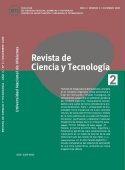COMPARACIÓN DE MEDIOS DE CULTIVO EMPLEADOS EN LA INVESTIGACIÓN DE SALMONELLA EN AGUAS
Contenido principal del artículo
Resumen
Se compararon distintos medios de cultivo para el aislamiento y caracterización de almonella en cursos de agua que recorren la ciudad de Posadas, Misiones. Se aislaron 1.730 cepas de las cuales, 484 (28%) fueron confirmadas como pertenecientes al género Salmonella. Se señala a S. Saphra como la serovar de mayor abundancia. Se aplicaron técnicas de incubación de alta temperatura (41,5ºC) con plaqueos sucesivos efectuados a distintos tiempos de incubación (24 y 72 horas). Se emplearon los siguientes caldos de enriquecimiento y medios de aislamiento: caldo Tetrationato con el agregado de 40 mg/l de Novobiocina (Tet); Dulcitol Selenito (DS) y Rappaport-Vassiliadis (RV); agar Eosina-Azul de Metileno (EMB); agar Desoxicolato-Citrato-Lactosa-Sacarosa (DCLS), agar Xilosa-Lisina-Desoxicolato (XLD) y agar Sulfito de Bismuto (BS). Los caldos de enriquecimiento más eficaces fueron DS y RV y la mejor combinación de caldos de enriquecimiento y medios de aislamiento resultó ser DS/BS, seguida por RV/BS.
Descargas
Detalles del artículo
La Revista de Ciencia y Tecnología sostiene su compromiso con las políticas de Acceso Abierto a la información científica, al considerar que tanto las publicaciones científicas como las investigaciones financiadas con fondos públicos deben circular en Internet en forma libre y gratuita. Los trabajos publicados en la Revista de Ciencia y Tecnología están bajo la licencia Creative Commons Atribución-NoComercial 2.5 Argentina.
Citas
BINSTEIN, N.; EIGUER, T.; D´EMPAIRE, M., Epidemia de salmonelosis en Buenos Aires y sus alrededores. Medicina (Buenos Aires). 42: 161-167. 1982.
BLASSER, M.; RAFUSE, E.; WELLS, J., An outbreak of salmonelosis involving multiple vehicles. Amer. J. Of Epidemiol. 114: 663-670. 1981.
ORGANIZACIÓN MUNDIAL DE LA SALUD, Programa de control de enfermedades diarreicas. Informe de grupos científicos de trabajo. 1978-1980.
ANSELMO, R.; BARRIOS, H.; VIOVA, S.; LLORENTE, B.; EIGUER, T.; CAFFER, M.; FLIESS, E., Estudio comparativo de cuatro métodos de aislamiento de salmonelas de aguas superficiales. Rev. Arg. De Microbiol. 21: 127-132. 1989.
HARVEY, R. W.; PRICE, T. H., Sewer and drain swabbing as a mean of investigating salmonellosis. J. Hyg. Cam. 68: 611-624. 1970.
Media specifications. En: RAND, M. C.; GREENBERG, A. E.; TARAS, M. J., Standard methods for the examination of water and wastewater. 14 de. p. 892-902. Washington, A.P.H.A. 1976.
Analitical Methodology – Section E, Salmonella – En: BORDNER, R.; WINTER, J., Microbiological Methods for Monitoring the Environment. P. 154-185; Cincinnati, E.P.A. 1978.
General qualitative isolation and identification procedures for Salmonella. En: RAND, M. C.; GREENBERG, A.; TARAS, M. J. (de.) Standard methods for the examinations of water and wastewater. 14. de. p. 955-960. Washington, A.P.H.A. 1976.
BENASSI, F. O.; MARTÍNEZ VÁZQUEZ, F.; EIGUER, T., Salmonella: su incidencia en aguas del arroyo Zaimán. Rev. Arg. de Microbiol. 15: 169-175. 1983.
MOORE, B., The detection of Paratyphoid carriers in towns by means of sewage examination. Monthly Bull. Minist. P. Hh. (London); 7: 241-248. 1948.
ANSELMO, R. J.; BARRIOS, H. A.; VIARA, S.; CAFFER, M. I., Aislamiento y caracterización de Salmonella de aguas del río Luján. Rev. Arg. de Microbiol - 23: 204-210. 1991.
Composition of media. En: BORDNER, R.; WINTER, J., Microbiological Methods for Monitoring the Environment. Cincinnati, E.P.A. 1978.
JEFFRIES, L., Novobiocin Tetrathionate Broth.A medium for improved selectivity for isolation of Salmonella from faeces. J. Clin. Path. 12: 568-571. 1979.
TRICHOPOULOS, D.; DASKALOPOULOS, G.; KALAPOTHAKI, V.; KALANDIDI, A.; VASSILIADIS, P., Enrichissement secondaire en milieu de Rappaport dans l´isolement de Salmonella, a partir d’organes de porcs. Zbl. Bakt. I. Orig., A 219, 306-312. 1972.
VASSILIASDIS, P., The RappaportVassiliadis enrichment medium for the isolation of Salmonella: an overview. J. Applied Bact. 54: 69-76. 1983.
MONTICELLI, L. S.; LASTA, J. A.; GARIBOGLIO, M. A., Aislamiento y cuantificación de Salmonella en aguas del Río de la Plata destinadas a recreación. Rev. Arg. de Microbiol. 16 (1): 1-10. 1984.
NASSIM NABBUT, H., Elevated temperature technique for the isolation of Salmonella from sewage and human faeces. J. Hyg. Camb. 71: 49-54. 1972.
SPINO, D. F., Elevated temperature technique for the isolation of Salmonella from streams. Appl. Microbiol. 14: 591-596. 1966.
HICKS, C., Fundamental concepts in the design of experiments. Saunders Coll. P. p. 30- 32. 1982.
YOSHPE, Y.; RIVKLIS, S. H.; PAIST, M., A convenient method for isolation of Salmonella from sewage and contaminated sea water. Water research. Pergamon Press. 4: 113-120. 1971.

